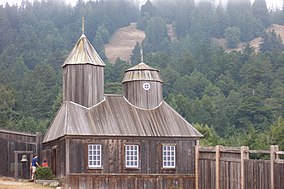| Fort Ross State Historic Park | |
|---|---|
 The reconstructed chapel of Fort Ross | |
| Location | Sonoma County, California, United States |
| Nearest city | Jenner, California |
| Coordinates | 38°30′51″N123°14′34″W / 38.51417°N 123.24278°W |
| Area | 3,393 acres (1,373 ha) |
| Established | 1909 |
| Governing body | California Department of Parks and Recreation |
Fort Ross State Historic Park is a historical state park in Sonoma County, California, including the former Russian fur trading outpost of Fort Ross plus the adjacent coastline and native coast redwood forests extending inland. It is located on the northern California coast about 12 miles north of the town of Jenner and 22 miles north of Bodega Bay. Fort Ross, active from 1812 to 1842, was the southernmost settlement in the Russian colonization of the Americas. [1] The 3,393-acre (1,373 ha) park was established in 1909. [2] The site is a Sonoma County Historic Landmark. [3]

